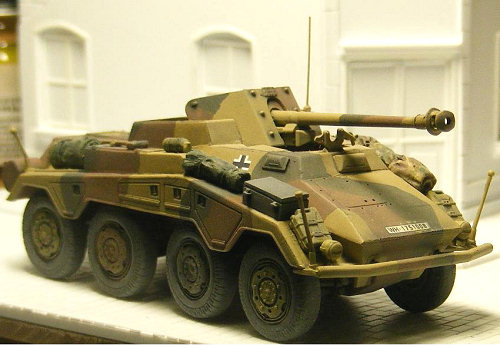 |
| Sd.Kfz. 234/4 8 rad Schwere Panzerspähwagen | ||||
| Kitbash | Construction Review by Dave Showell- showell1(at)rogers(dot)com | |||
| Way
back in May of 2009 Doug invited me to participate in a
group build/challenge. The idea was for Doug, Stephen
Brezinzki, Jim Matthiessen and myself to all take a shot
at building (and finishing!) one of the Sd.Kfz. 234
models currently on the market. Well, after a year, here
is my write-up. In my own defense, I did get this
complete for the AMPS 2010 international show in the
spring; it just took me another few months to get around
to writing it up. The final product received a silver
medal in the advanced category at AMPS. The judges picked
up a seam on the gun barrel and that one of the road
wheels was floating above the road, two errors that would
immediately knock a kit out of the gold category.
The Vehicle The 234 series of armoured cars was developed beginning in 1940 to replace the obsolescent 231 series. The "Pakwagen" version, carrying the 75 mm Pak 40, was designed to provide an anti-tank punch to the armoured car companies of reconnaissance (Aufklärungs) battalions of Panzer and Panzergrenadier divisions. 89 234/4 vehicles were produced, compared with 200 234/1 (20 mm gun), 99 234/2 (the Puma), and 88 234/3 (short 75 mm) vehicles. The design was successful with a high road speed (80 km/hr) and reasonable armour, but with the Pak 40 mounted the vehicle was overloaded. The Kit Both Italeri and Roden currently produce versions of this vehicle, although neither is quite right. The Italeri version suffers from simplified running gear and uses the old ESCI Pak 40, which is moulded "in battery" (i.e. in partial if not full recoil). The Roden kit is nicer but the running gear is very delicate and the rear deck is not right. Hasagawa, on the other hand, produces very nicely detailed kits of the 234/1, /2 and /3 but not the /4 yet. Also, on the Hasagawa kits the wheels lack the semi-circular cooling vents that are normally found around the wheel hubs on this vehicle. On the plus side, Hasagawa provides two different styles tires - in the field 234s were often seen with more than one type of tire on the same vehicle. Also, they have included a pretty good interior. So for this model I decided to use the best bits from the three manufacturers, and added in the new Pak 40 from Dragon for good measure. I used: 1) the lower hull, interior and most of the running gear from the Hasagawa kit: 2) the wheel hubs were cut from the Roden wheels (which has the proper cooling cut-outs, but crappy tread detail) and added to the Hasagawa wheels (which are moulded without the cooling vents but have nice side detail on the tires):
3) The upper hull is from the Italeri kit (mainly because the cut-out for the pak was already there - there isn't much to choose between the Hasagawa and Italeri upper hulls) and the fenders are from Hasagawa (because they were thinner and more crisply detailed); 4) The gun from the Dragon Sd.Kfz 251/22 halftrack kit (Dragon has the best Pak 75 going in my view), using the Italeri mounting. The opening for the gun in the Italeri hull was a bit small so I had to carefully enlarge it to get the Dragon gun to fit. I also think that in my model the gun carriage (the slide under the breach) sits back too far in the fighting compartment but I couldn't think of a way to extend the space, so I left it as is. Note that I added the bolts around the hull access hatches - completely invisible once the hull top was in place! The completed gun, painted and in place with crew equipment surrounding it. Additional details:
Paint From what I understand, the late issue of these vehicles came from the factory with the camoflage already applied over the dark yellow base. From the colour plates I've seen, this seems to be applied with hard edges (not with "feathered" sprayed edges). To simulate this, I decided to try the technique of using silicon putty (or silly putty here in North America) to mask off the hard-edged cammo. It looks UGLY in the in-process shots but turned out okay in the end. I started by spraying the entire model in German red-brown (a mix of Model Master acrylics). The interior and the under carriage (which is painted in red primer) were masked off with foil. Then I added "worms" of rolled putty. I then shot whole model again in dark green (over the putty I just put on). Once it was dry, I added a second layer of putty "worms" and, finally, I shot it one last time in Dunklegelb (the base coat). The result, once the putty was removed, was a pretty good resemblance to hard-edged cammo. A wash of heavily thinned black enamel was used to highlight detail. The model was clear-coated in gloss prior to the decals being applied. Model Master Clear Flat, mixed with a lot of thinner and a bit of Tamiya Buff was used to seal the decals. The wheels were painted in Humbrol 67 Matt Panzer Dark Grey, with a lighter dry brushing of Humbrol 64 Matt Light Grey. The final step was an over-all light dusting with the airbrush in Tamiya Buff. The Base The base is home made, using plastic stock and a wall from railroad modeling supplies. Source Documents Chamberlain and Doyle, Encyclopedia of German Tanks of World War Two, Revised Edition, Arms and Armour, London 1999. Perrett and Culver, German Armoured Cars and Recce Half-Tracks 1939-45, Osprey-Vanguard, London, 1981. |
| Back to Sd.Kfz. 234/4 Article | Back to Home Page |
| Article Last Updated: 9 January 2011 |